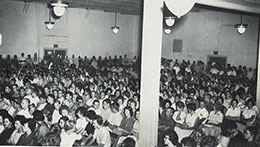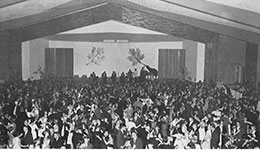Volume 32 · Number 1 · Fall 2014
Freeborn Hall: The campus grows up

An interior view of the old Rec Hall, from the 1962 yearbook
Freeborn Hall was constructed as a multi-use replacement to the campus’ old Recreation Hall, a wood-shingle 1921 building that in its early years did double duty as a gymnasium and a library.
The 1962 El Rodeo yearbook hailed the versatile new hall for its ability to keep pace with a fast-changing university.
Over the years, students have filed through the doors of Freeborn for a revolving series of events — class lectures, academic conferences, rallies, dances, commencement ceremonies and, before the days of online registration, to sign up for their courses.
During the annual Picnic Day, the hall resounded with the clatter of forks and knives at CAAA pancake breakfasts, the click of heels on runway at design students’ fashion shows, the lilting music of the Danzantes del Alma dance performances.
It was also a community venue — hosting numerous Powwows, high school graduations and other regional functions. The last event held in Freeborn, said Villalobos, assistant director of Campus Recreation and Unions, was a dance for athletes of the 2014 Special Olympics Northern California Summer Games.

Students attend a semi-formal dance in the then-new Freeborn Hall.
Before the 2002 opening of the Mondavi Center for the Performing Arts, Freeborn was also longtime home to the UC Davis Symphony Orchestra and the venue for campus arts and cultural programming.
Steve Weiss ’86, former director of ASUCD Student Forums and former assistant director and director of University Cultural Programs, said Freeborn presented challenges as a venue. When he first began working there as an undergraduate, the seating in the hall was flat. “If you were back 15 rows, you better hope that nobody tall was in front of you.”
Renovations in the late 1980s included the addition of bleacher-style seating and ceiling baffles to improve the acoustics for orchestral music. Limitations remained, but Weiss said Freeborn allowed the university to book top speakers and performing artists — building a regional audience to support the construction of the Mondavi Center.
What will happen next to Freeborn? A committee of students, faculty and staff is working with architects to determine if it can be suitably rebuilt or if a new, bigger building is needed.
Back to "Freeborn Hall Retrospective"
